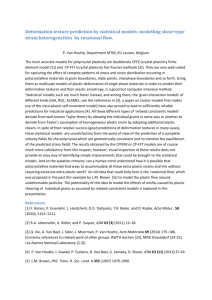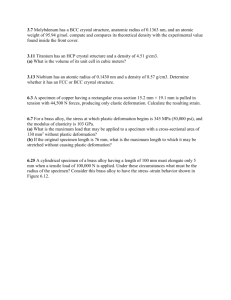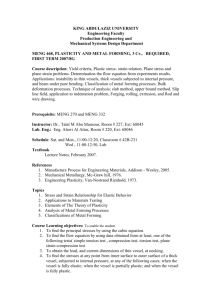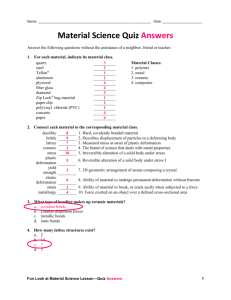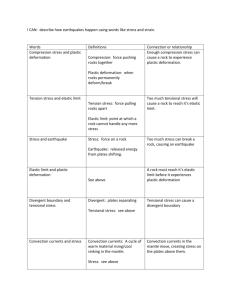8.1 Introduction to Plasticity
advertisement
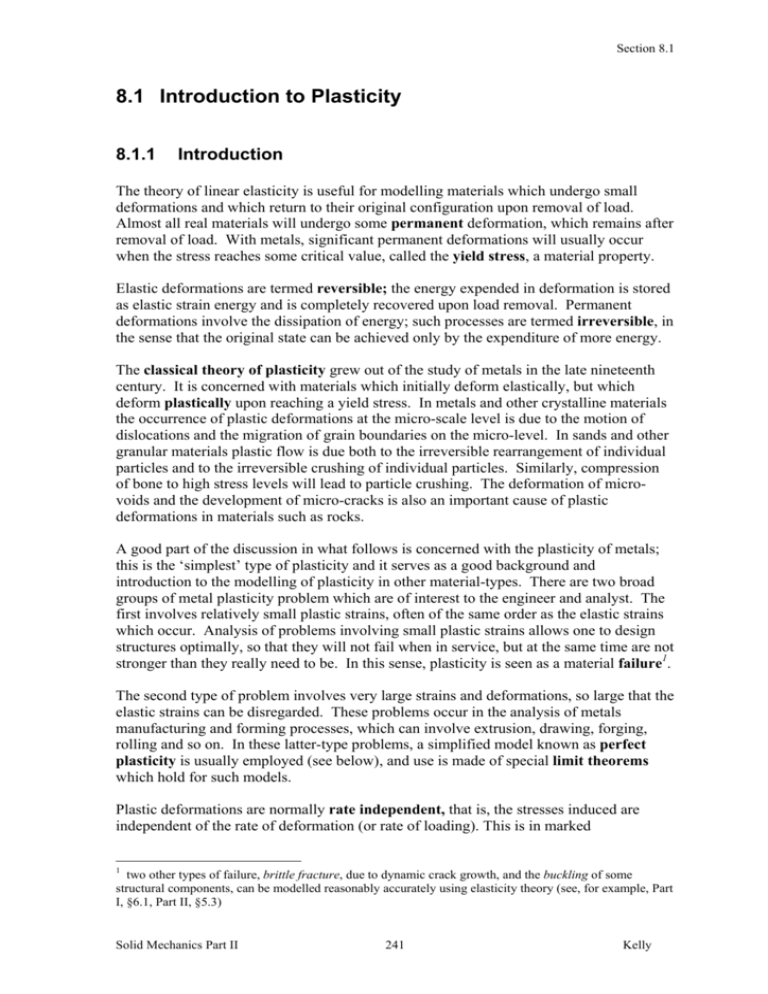
Section 8.1
8.1 Introduction to Plasticity
8.1.1
Introduction
The theory of linear elasticity is useful for modelling materials which undergo small
deformations and which return to their original configuration upon removal of load.
Almost all real materials will undergo some permanent deformation, which remains after
removal of load. With metals, significant permanent deformations will usually occur
when the stress reaches some critical value, called the yield stress, a material property.
Elastic deformations are termed reversible; the energy expended in deformation is stored
as elastic strain energy and is completely recovered upon load removal. Permanent
deformations involve the dissipation of energy; such processes are termed irreversible, in
the sense that the original state can be achieved only by the expenditure of more energy.
The classical theory of plasticity grew out of the study of metals in the late nineteenth
century. It is concerned with materials which initially deform elastically, but which
deform plastically upon reaching a yield stress. In metals and other crystalline materials
the occurrence of plastic deformations at the micro-scale level is due to the motion of
dislocations and the migration of grain boundaries on the micro-level. In sands and other
granular materials plastic flow is due both to the irreversible rearrangement of individual
particles and to the irreversible crushing of individual particles. Similarly, compression
of bone to high stress levels will lead to particle crushing. The deformation of microvoids and the development of micro-cracks is also an important cause of plastic
deformations in materials such as rocks.
A good part of the discussion in what follows is concerned with the plasticity of metals;
this is the ‘simplest’ type of plasticity and it serves as a good background and
introduction to the modelling of plasticity in other material-types. There are two broad
groups of metal plasticity problem which are of interest to the engineer and analyst. The
first involves relatively small plastic strains, often of the same order as the elastic strains
which occur. Analysis of problems involving small plastic strains allows one to design
structures optimally, so that they will not fail when in service, but at the same time are not
stronger than they really need to be. In this sense, plasticity is seen as a material failure1.
The second type of problem involves very large strains and deformations, so large that the
elastic strains can be disregarded. These problems occur in the analysis of metals
manufacturing and forming processes, which can involve extrusion, drawing, forging,
rolling and so on. In these latter-type problems, a simplified model known as perfect
plasticity is usually employed (see below), and use is made of special limit theorems
which hold for such models.
Plastic deformations are normally rate independent, that is, the stresses induced are
independent of the rate of deformation (or rate of loading). This is in marked
1
two other types of failure, brittle fracture, due to dynamic crack growth, and the buckling of some
structural components, can be modelled reasonably accurately using elasticity theory (see, for example, Part
I, §6.1, Part II, §5.3)
Solid Mechanics Part II
241
Kelly
Section 8.1
contrast to classical Newtonian fluids for example, where the stress levels are
governed by the rate of deformation through the viscosity of the fluid.
Materials commonly known as “plastics” are not plastic in the sense described here.
They, like other polymeric materials, exhibit viscoelastic behaviour where, as the
name suggests, the material response has both elastic and viscous components. Due
to their viscosity, their response is, unlike the plastic materials, rate-dependent.
Further, although the viscoelastic materials can suffer irrecoverable deformation,
they do not have any critical yield or threshold stress, which is the characteristic
property of plastic behaviour. When a material undergoes plastic deformations, i.e.
irrecoverable and at a critical yield stress, and these effects are rate dependent, the
material is referred to as being viscoplastic.
Plasticity theory began with Tresca in 1864, when he undertook an experimental program
into the extrusion of metals and published his famous yield criterion discussed later on.
Further advances with yield criteria and plastic flow rules were made in the years which
followed by Saint-Venant, Levy, Von Mises, Hencky and Prandtl. The 1940s saw the
advent of the classical theory; Prager, Hill, Drucker and Koiter amongst others brought
together many fundamental aspects of the theory into a single framework. The arrival of
powerful computers in the 1980s and 1990s provided the impetus to develop the theory
further, giving it a more rigorous foundation based on thermodynamics principles, and
brought with it the need to consider many numerical and computational aspects to the
plasticity problem.
8.1.2
Observations from Standard Tests
In this section, a number of phenomena observed in the material testing of metals will be
noted. Some of these phenomena are simplified or ignored in some of the standard
plasticity models discussed later on.
At issue here is the fact that any model of a component with complex geometry, loaded in
a complex way and undergoing plastic deformation, must involve material parameters
which can be obtained in a straight forward manner from simple laboratory tests, such as
the tension test described next.
The Tension Test
Consider the following key experiment, the tensile test, in which a small, usually
cylindrical, specimen is gripped and stretched, usually at some given rate of stretching
(see Part I, §5.2.1). The force required to hold the specimen at a given stretch is recorded,
Fig. 8.1.1. If the material is a metal, the deformation remains elastic up to a certain force
level, the yield point of the material. Beyond this point, permanent plastic deformations
are induced. On unloading only the elastic deformation is recovered and the specimen
will have undergone a permanent elongation (and consequent lateral contraction).
In the elastic range the force-displacement behaviour for most engineering materials
(metals, rocks, plastics, but not soils) is linear. After passing the elastic limit (point A in
Fig. 8.1.1), the material “gives” and is said to undergo plastic flow. Further increases in
load are usually required to maintain the plastic flow and an increase in displacement; this
Solid Mechanics Part II
242
Kelly
Section 8.1
phenomenon is known as work-hardening or strain-hardening. In some cases, after an
initial plastic flow and hardening, the force-displacement curve decreases, as in some
soils; the material is said to be softening. If the specimen is unloaded from a plastic state
(B) it will return along the path BC shown, parallel to the original elastic line. This is
elastic recovery. The strain which remains upon unloading is the permanent plastic
deformation. If the material is now loaded again, the force-displacement curve will retrace the unloading path CB until it again reaches the plastic state. Further increases in
stress will cause the curve to follow BD.
Two important observations concerning the above tension test (on most metals) are the
following:
(1) after the onset of plastic deformation, the material will be seen to undergo negligible
volume change, that is, it is incompressible.
(2) the force-displacement curve is more or less the same regardless of the rate at which
the specimen is stretched (at least at moderate temperatures).
hardening
force
Yield point
elastic
loading
A
unload
0
D
B
load
displacement
C
plastic
elastic
deformation deformation
Figure 8.1.1: force/displacement curve for the tension test
Nominal and True Stress and Strain
There are two different ways of describing the force F which acts in a tension test. First,
normalising with respect to the original cross sectional area of the tension test specimen
A0 , one has the nominal stress or engineering stress,
n
F
A0
(8.1.1)
Alternatively, one can normalise with respect to the current cross-sectional area A,
leading to the true stress,
Solid Mechanics Part II
243
F
A
(8.1.2)
Kelly
Section 8.1
in which F and A are both changing with time. For very small elongations, within the
elastic range say, the cross-sectional area of the material undergoes negligible change and
both definitions of stress are more or less equivalent.
Similarly, one can describe the deformation in two alternative ways. Denoting the
original specimen length by l 0 and the current length by l, one has the engineering strain
l l0
l0
(8.1.3)
Alternatively, the true strain is based on the fact that the “original length” is continually
changing; a small change in length dl leads to a strain increment d dl / l and the
total strain is defined as the accumulation of these increments:
l
dl
ln
l
l0
l0
l
t
(8.1.4)
The true strain is also called the logarithmic strain or Hencky strain. Again, at small
deformations, the difference between these two strain measures is negligible. The true
strain and engineering strain are related through
t ln 1
(8.1.5)
Using the assumption of constant volume for plastic deformation and ignoring the very
small elastic volume changes, one has also {▲Problem 3}
n
l
.
l0
(8.1.6)
The stress-strain diagram for a tension test can now be described using the true
stress/strain or nominal stress/strain definitions, as in Fig. 8.1.2. The shape of the
nominal stress/strain diagram, Fig. 8.1.2a, is of course the same as the graph of force
versus displacement (change in length) in Fig. 8.1.1. A here denotes the point at which
the maximum force the specimen can withstand has been reached. The nominal stress at
A is called the Ultimate Tensile Strength (UTS) of the material. After this point, the
specimen “necks”, with a very rapid reduction in cross-sectional area somewhere about
the centre of the specimen until the specimen ruptures, as indicated by the asterisk.
Note that, during loading into the plastic region, the yield stress increases. For example,
if one unloads and re-loads (as in Fig. 8.1.1), the material stays elastic up until a stress
higher than the original yield stress Y. In this respect, the stress-strain curve can be
regarded as a yield stress versus strain curve.
Solid Mechanics Part II
244
Kelly
Section 8.1
n
A
Y
A
Y
t
(a )
(b)
Figure 8.1.2: typical stress/strain curves; (a) engineering stress and strain, (b) true
stress and strain
Compression Test
A compression test will lead to similar results as the tensile stress. The yield stress in
compression will be approximately the same as (the negative of) the yield stress in
tension. If one plots the true stress versus true strain curve for both tension and
compression (absolute values for the compression), the two curves will more or less
coincide. This would indicate that the behaviour of the material under compression is
broadly similar to that under tension. If one were to use the nominal stress and strain,
then the two curves would not coincide; this is one of a number of good reasons for using
the true definitions.
The Bauschinger Effect
If one takes a virgin sample and loads it in tension into the plastic range, and then unloads
it and continues on into compression, one finds that the yield stress in compression is not
the same as the yield strength in tension, as it would have been if the specimen had not
first been loaded in tension. In fact the yield point in this case will be significantly less
than the corresponding yield stress in tension. This reduction in yield stress is known as
the Bauschinger effect. The effect is illustrated in Fig. 8.1.3. The solid line depicts the
response of a real material. The dotted lines are two extreme cases which are used in
plasticity models; the first is the isotropic hardening model, in which the yield stress in
tension and compression are maintained equal, the second being kinematic hardening, in
which the total elastic range is maintained constant throughout the deformation.
Solid Mechanics Part II
245
Kelly
Section 8.1
2Y0
Y0
Y1
t
kinematic hardening
Y1
isotropic hardening
Figure 8.1.3: The Bauschinger effect
The presence of the Bauschinger effect complicates any plasticity theory. However, it is
not an issue provided there are no reversals of stress in the problem under study.
Hydrostatic Pressure
Careful experiments show that, for metals, the yield behaviour is independent of
hydrostatic pressure. That is, a stress state xx yy zz p has negligible effect on
the yield stress of a material, right up to very high pressures. Note however that this is
not true for soils or rocks.
8.1.3
Assumptions of Plasticity Theory
Regarding the above test results then, in formulating a basic plasticity theory with which
to begin, the following assumptions are usually made:
(1)
(2)
(3)
(4)
(5)
the response is independent of rate effects
the material is incompressible in the plastic range
there is no Bauschinger effect
the yield stress is independent of hydrostatic pressure
the material is isotropic
The first two of these will usually be very good approximations, the other three may or
may not be, depending on the material and circumstances. For example, most metals can
be regarded as isotropic. After large plastic deformation however, for example in rolling,
the material will have become anisotropic: there will be distinct material directions and
asymmetries.
Together with these, assumptions can be made on the type of hardening and on whether
elastic deformations are significant. For example, consider the hierarchy of models
illustrated in Fig. 8.1.4 below, commonly used in theoretical analyses. In (a) both the
elastic and plastic curves are assumed linear. In (b) work-hardening is neglected and the
Solid Mechanics Part II
246
Kelly
Section 8.1
yield stress is constant after initial yield. Such perfectly-plastic models are particularly
appropriate for studying processes where the metal is worked at a high temperature – such
as hot rolling – where work hardening is small. In many areas of applications the strains
involved are large, e.g. in metal working processes such as extrusion, rolling or drawing,
where up to 50% reduction ratios are common. In such cases the elastic strains can be
neglected altogether as in the two models (c) and (d). The rigid/perfectly-plastic model
(d) is the crudest of all – and hence in many ways the most useful. It is widely used in
analysing metal forming processes, in the design of steel and concrete structures and in
the analysis of soil and rock stability.
Y
Y
0
0
(a) Linear Elastic-Plastic
(b) Elastic/Perfectly-Plastic
Y
Y
0
0
(c) Rigid/Linear Hardening
(d) Rigid-Perfectly-Plastic
Figure 8.1.4: Simple models of elastic and plastic deformation
8.1.4
The Tangent and Plastic Modulus
Stress and strain are related through E in the elastic region, E being the Young’s
modulus, Fig. 8.1.5. The tangent modulus K is the slope of the stress-strain curve in the
plastic region and will in general change during a deformation. At any instant of strain,
the increment in stress d is related to the increment in strain d through2
d Kd
(8.1.7)
the symbol here represents the true strain (the subscript t has been dropped for clarity); as mentioned,
when the strains are small, it is not necessary to specify which strain is in use since all strain measures are
then equivalent
2
Solid Mechanics Part II
247
Kelly
Section 8.1
K
d p
d e
d
E
Figure 8.1.5: The tangent modulus
After yield, the strain increment consists of both elastic, e , and plastic, d p , strains:
d d e d p
(8.1.8)
The stress and plastic strain increments are related by the plastic modulus H:
d H d p
(8.1.9)
1 1 1
K E H
(8.1.10)
and it follows that {▲Problem 4}
8.1.5
Friction Block Models
Some additional insight into the way plastic materials respond can be obtained from
friction block models. The rigid perfectly plastic model can be simulated by a Coulomb
friction block, Fig. 8.1.6. No strain occurs until reaches the yield stress Y. Then there
is movement – although the amount of movement or plastic strain cannot be determined
without more information being available. The stress cannot exceed the yield stress in
this model:
Y
(8.1.11)
If unloaded, the block stops moving and the stress returns to zero, leaving a permanent
strain, Fig. 8.1.6b.
Solid Mechanics Part II
248
Kelly
Section 8.1
unload
Y
permanent
deformation
(a)
(b)
Figure 8.1.6: (a) Friction block model for the rigid perfectly plastic material, (b)
response of the rigid-perfectly plastic model
The linear elastic perfectly plastic model incorporates a free spring with modulus E in
series with a friction block, Fig. 8.1.7. The spring stretches when loaded and the block
also begins to move when the stress reaches Y, at which time the spring stops stretching,
the maximum possible stress again being Y. Upon unloading, the block stops moving and
the spring contracts.
E
Y
Figure 8.1.7: Friction block model for the elastic perfectly plastic material
The linear elastic plastic model with linear strain hardening incorporates a second,
hardening, spring with stiffness H, in parallel with the friction block, Fig. 8.1.8. Once the
yield stress is reached, an ever increasing stress needs to be applied in order to keep the
block moving – and elastic strain continues to occur due to further elongation of the free
spring. The stress is then split into the yield stress, which is carried by the moving block,
and an overstress Y carried by the hardening spring.
Upon unloading, the block “locks” – the stress in the hardening spring remains constant
whilst the free spring contracts. At zero stress, there is a negative stress taken up by the
friction block, equal and opposite to the stress in the hardening spring.
The slope of the elastic loading line is E. For the plastic hardening line,
e p
E
Y
H
K
d
EH
d E H
(8.1.12)
It can be seen that H is the plastic modulus.
Solid Mechanics Part II
249
Kelly
Section 8.1
H
E
(a)
Y
(b)
e
(c)
e
p
(d)
0
e 0
p
Figure 8.1.8: Friction block model for a linear elastic-plastic material with linear
strain hardening; (a) stress-free, (b) elastic strain, (c) elastic and plastic strain, (d)
unloading
8.1.6
Problems
1. Give two differences between plastic and viscoelastic materials.
2. A test specimen of initial length 0.01 m is extended to length 0.0101 m. What is the
percentage difference between the engineering and true strains (relative to the
engineering strain)? What is this difference when the specimen is extended to length
0.015 m?
3. Derive the relation 8.1.6, / n l / l 0 .
4. Derive Eqn. 8.1.10.
5. Which is larger, H or K? In the case of a perfectly-plastic material?
6. The Ramberg-Osgood model of plasticity is given by
E b
where E is the Young’s modulus and b and n are model constants (material
parameters) obtained from a curve-fitting of the uniaxial stress-strain curve.
e
Solid Mechanics Part II
p
250
n
Kelly
Section 8.1
Find the tangent and plastic moduli in terms of plastic strain p (and the
material constants).
x 10
5.5
A material with model
(ii)
E 70GPa
5
parameters n 4 ,
b 800MPa
4.5
E 70 GPa and
4
n4
b 800 MPa is strained
3.5
n3
in tension to p 0.02
3
and is subsequently
2.5
n2
unloaded and put into
2
compression. Find the
1.5
stress at the initiation of
1
n 1
compressive yield
0.5
assuming isotropic
0
0
0.02 0.04 0.06 0.08
0.1
0.12 0.14 0.16 0.18
0.2
hardening.
[Note that the yield stress is actually zero in this model, although the plastic strain at
relatively low stress levels is small for larger values of n.]
(i)
8
7. Consider the plasticity model shown below.
What is the elastic modulus?
(i)
What is the yield stress?
(ii)
(iii) What are the tangent and plastic moduli?
Draw a typical loading and unloading curve.
E2
E1
Y
8. Draw the stress-strain diagram for a cycle of loading and unloading to the rigid plastic model shown here. Take the maximum load reached to be max 4Y1 and
Y2 2Y1 . What is the permanent deformation after complete removal of the load?
[Hint: split the cycle into the following regions: (a) 0 Y1 , (b) Y1 3Y1 , (c)
3Y1 4Y1 , then unload, (d) 4Y1 3Y1 , (e) 3Y1 2Y1 , (f) 2Y1 0 .]
E2
E1
Y1
Y2
Solid Mechanics Part II
251
Kelly

